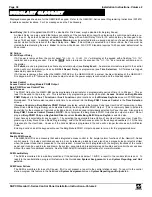
NAPCO Gemini C-Series Control Panel Installation Instructions--Volume 2
Page 48 Installation Instructions, Volume 2
per the SIA CP-01 standards: (1) Exit Delay Time: If an attempt is made to change the Exit Delay time to less than 45 sec-
onds the time will be entered as 60 seconds. The maximum programmable time is 255 seconds; (2) Entry Delay: If an at-
tempt is made to change the Entry Delay time to less than 30 seconds the time will be entered as 30 seconds. The maximum
programmable time is 255 seconds; and (3) Abort Delay: If an attempt is made to change the Abort Delay to less than 15 sec-
onds or more than 45 seconds the time will be entered as 30 seconds.
NOTE:
In accordance with UL standards, the aggregate of the Entry Delay time and Abort Delay time "window" will not be
programmed to exceed one minute.
Note:
When this option is enabled, the Exit Delay keypad sounder (including the Exit
Urgency sound during the final 10 seconds of the Exit Delay) is enabled.
Note:
If this option is enabled in EZ Programming,
any Zone in a Group
will only activate an alarm and send a report ONCE
. After the Zone has reported, it will remain in the
Group and may still initiate the Zone ANDing sequence.
Enable Telephone Line 1 Fault Test
;
Enable Telephone Line 2 Fault Test
;
Telco Line Test Delay
(see Fire Glossary)
Enable User Code by Area
See
User Closing and Opening Reports by Telephone Numbers
Entry/Exit Delay
,
Entry/Exit 1; Entry/Exit 2
,
Entry Relay
,
Disable Area Entry Relays
,
Enable Exit-Delay Restart
Delays permit exit and entry through the Entry/Exit Zone(s) after the system is armed without setting off an immediate alarm.
Entry delay allows the user time to enter and disarm the panel. Exit delay allows the user to leave the premises after the
panel has been armed. Unless the keypad has been configured otherwise, the sounder will come on and will pulse during the
last 10 seconds of entry delay to remind the user to disarm.
Two individually-programmable entry-delay times are provided to accommodate different entry zones. If two or more Exit/
Entry Zones are entered in succession, the delay programmed for the last Exit/Entry Zone entered will take precedence over
all others. Exit-Delay time and Entry-Delay time may each be programmed for up to 255 seconds (4 minutes). See Time Se-
lection.
An external output/relay may be programmed to trip upon entry (see Programming Manual: "Relay Event ID Codes" & "Area
Entry Relays"), and remain on for a programmed duration.
If the system has been armed with Exit-Delay Restart enabled, when the exit door is opened and then closed, the pro-
grammed exit delay will restart at 60 seconds. Thus, if a long exit delay is programmed, it will be reduced to 60 seconds after
exiting, yet still allow reentry before entry time starts. If re-entry occurs within that 60 seconds, exit delay will restart once
again (and only once again) at 60 seconds.
If re-entry occurs within 60 seconds after exit delay has expired, the alarm will sound a 2-second warning (with the entry
sounder) to remind the user to disarm. (Exit-Delay Restart may be useful in reducing false alarms caused by a user who re-
enters the premises shortly after exiting.)
Note:
In UL installations, maximum exit delay is 60 seconds; maximum entry delay is 45 seconds. In UL Mercantile installa-
tions, maximum entry delay is 45 seconds.
Entry delay may be canceled by pressing the
F
button prior to arming, however it will be restored automatically upon dis-
arming. (When armed with Instant protection, an "
I
" will appear at the right side of the display.)
Exit/Entry Follower
A zone programmed as an Exit/Entry Follower will ignore detection during the exit delay, and only during entry delay if the
Exit/Entry Zone is entered first. Thus, detection devices (passive infrared detectors, for example) along the path between the
keypad and the exit/entry door will not signal an alarm during exit/entry delay under normal conditions. However, if a device
in the Exit/Entry Follower Zone detects a violation when the exit/entry door has not first been entered, there will be no entry
delay and the Exit/Entry Follower Zone will go into an instant alarm.
If the panel is armed with the entry delays canceled (Instant protection), any violation on the Exit/Entry Zone or the Exit/Entry
Follower Zone will cause an immediate alarm.
Expansion Zones
EZM Type
EZM PGM Armed Terminal Control
EZM Tamper
See
Tamper
Zones 9 and above are expansion zones added to the basic system using a GEMC-EZM8. Refer to ADD EXPANSION
ZONES (in Volume 1) and the Wiring Diagram. Also see the instructions accompanying each module for wiring information.
Regardless of how the modules are arranged, the expansion zones are divided into consecutively-numbered groups of four.
Each module may comprise 1 group (4 zones) or 2 groups (8 zones).
NOTE:
The default setting is 2 groups (8 zones).
Place jumper J1 on #7 for 4 zone, remove for 8 zone. See WI1683 for additional specifications and other information.
EZM Assignments
The "EZM Assignments" tab is used to setup the descriptions, type, and PGM output for all the EZM's used in an installation.
Full upload, and then put panel into service
(see Fire Glossary)
BURGLARY GLOSSARY
















































